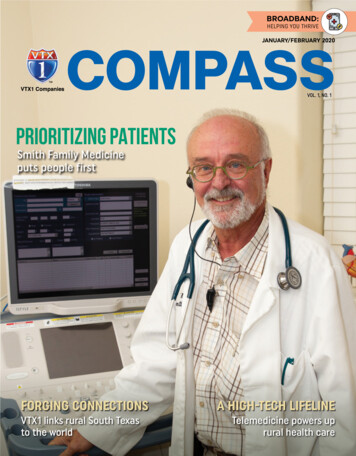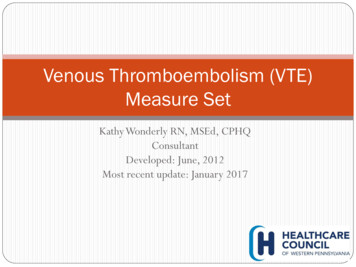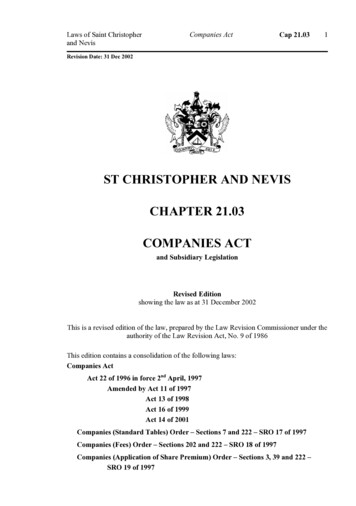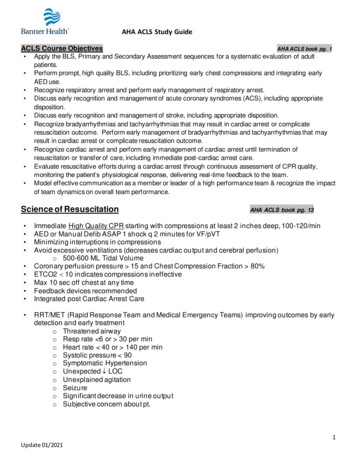
Transcription
BROADBAND:HELPING YOU THRIVEJANUARY/FEBRUARY 2020COMPASSVOL. 1, NO. 1PRIORITIZING PATIENTSSmith Family Medicineputs people firstFORGING CONNECTIONSVTX1 links rural South Texasto the worldA HIGH-TECH LIFELINETelemedicine powers uprural health care
INDUSTRY NEWSRural ConnectionsBy SHIRLEY BLOOMFIELD, CEONTCA–The Rural Broadband AssociationA good way tostart the New YearNTCA members make a real difference in their communities, and inthe lives of the people they serve.I was reminded of this a few weeks agowhen the Foundation for Rural Serviceannounced it had awarded 100,000in FRS Community Grants to groupsthroughout the U.S. FRS is the nonprofitarm of NTCA that supports rural telecomcompanies, consumers and policymakerswith educational information, products andprogramming.Each year, community organizations apply for FRS grants to help themtackle challenges ranging from accessingtechnology and improving educationalofferings to providing telemedicine andfirst-responder services to rural areas.Applications are sponsored by their localtelco.It was also exciting to see the USDAaward several ReConnect grants and loansto NTCA members toward the end of theyear. This program represents yet anotheroption for rural broadband funding, aswell as an example of public/private partnerships at work to extend broadband tounserved communities.After all, investments by federal andstate agencies, coupled with the commitment of rural broadband providers, arekey to our nation’s progress in connectingthe millions of citizens still without accessto fast, reliable internet service.These programs, as well as the engagement we saw among policymakers at ourTelecom Executive Policy Summit inNovember, provide a strong start to 2020and give me great hope for a strong newyear for rural broadband. 2 January/February 2020Are you ready for atelehealth future?Story by STEPHEN V. SMITHThe presence of reliable broadband service holds great promise for ruralAmerica. While it touches many facets of life, broadband’s greatest impactmay very well be in the area of health care. Consider this statement fromthe Federal Communications Commission:“Advances in telemedicine are transforming health care from a service delivered solely through traditional brick and mortar health care facilities to connectedcare options delivered via a broadband internet access connection directly to thepatient’s home or mobile location.”While reliable access to a broadband network is still out of reach for millionsof rural Americans, hundreds of cooperative and independent telecommunicationscompanies across the country are delivering world-class internet service, oftenover a fiber connection. If you received this magazine in the mail, your local telcois one of those leading-edge providers.If access to broadband is becoming less of the challenge to telehealth’s widescale availability, what is the greatest challenge? The FCC recently tasked theIntergovernmental Advisory Committee with studying and reporting on telehealthbarriers and incentives. The report stated that “people-based” issues offer the mostsignificant challenges to telehealth adoption. While this includes many factors,such as policy and licensing, broadband adoption is a leading concern.In other words, the technology is there. Now, people need to embrace it.“Increasing support must be given to rural and disadvantaged communities sothat digital literacy and adoption does not exacerbate the digital divide,” the IACreport states. Quite simply, the presence of broadband doesn’t mean patients anddoctors are ready to put it to use as part of their health care program.Are you ready? Do you understand the implications of telehealth? What stepscan you take toward enjoying its benefits?Begin by asking your doctor what programs are available. This could includeconnected medical devices in your home or something as simple as remote monitoring via an app on your smartphone or tablet. Of course, access to telehealthstarts with subscribing to broadband service that will support this life-changingtechnology. And once in place, broadband has the potential to enhance your life inmany other ways as well.
Knowledge is powerDoes your digitalknow-how stand up?Story by NOBLE SPRAYBERRYConvenience and power. Internet services bring both.Online bill pay eliminates a tedious task. Social media cankeep family ties strong or reconnect you with old friends.Streaming services bring a wealth of music, books and more.But when it comes to digital tools, knowledge is power,and the Pew Research Center’s recent “Americans and DigitalKnowledge” report found that a majority of adults in the U.S.QIf a website uses cookies, it meansthat the site A: Cookies allow websites to track uservisits and site activity. They are common, and you are often tracked acrossthe websites you visit.forms. Often advertising is personalizedto you by information gathered fromnot only your activities on a socialmedia site but also your actions onother websites.QQQQWhere might someone encountera phishing scam?A: Phishing scams can occur on socialmedia, websites, email or text messages. Each form of communicationoffers an avenue for exploitation. Foradditional tips to improve your onlinesecurity, visit FCC.gov/consumer-guides.What is the largest source of revenue for most major social mediaplatforms? (Several possible optionswere listed.)A: Advertising is the largest source ofrevenue for most social media plat-could not correctly answer half of the survey’s 10 multiplechoice questions.Questions touched on security and a general understandingof technology. Here are a few of the queries, edited for clarity,focused on security and privacy — good information to know.The answers do include additional context and tips not includedin the report.When a website has a privacypolicy, it means that the site A: Privacy policies are contractsbetween websites and users about howthose sites will use their data. Oftenlong and legalistic, the agreements mayoutline how your private informationcan be used to target advertising orwhether or not your information can beshared with other companies.What does it mean when a websitehas “https://” at the beginning ofits URL, as opposed to “http://” without the “s”?A: “https://” in a URL means thatWant to see the entire report?information entered into the site isencrypted. Look for “https://” beforecompleting any financial transaction ona site.QMany web browsers offer a featureknown as “private browsing” or“incognito mode.” If someone opensa webpage on their computer at workusing incognito mode, who will be ableto see their online activities?A: Private browsing mode only preventssomeone using the same computerfrom seeing one’s online activities.In most cases, your internet provider,including your phone wireless provider,can see all digital traffic passing fromyour device to the internet.Do a Google search for “Pew Research Centerand Americans and Digital Knowledge.”January/February 2020 3
FROM THE CEOCOMPASSJANUARY/FEBRUARY 2020VOL. 1, NO. 1Introducing COMPASSmagazineVTX1 Companies is investing in our community, andwe have something fresh to unveil. We are pleasedto introduce the new COMPASS magazine.VTX1 is deeply committed to those we serve inSouth Texas. In order to share the stories of thosecommunities and our role within them, we’vedeveloped this new member magazine — now biggerand better than any communications piece we’ve donebefore.Our goal is to improve our communication withmembers and customers alike, which will helpDAVE OSBORNeducate about new industry trends, communityChief Executive Officeractivities and news from your cooperative. Withour new format, we will publish magazines like thisone six times a year. With our continued growth and the changes within ourindustry, we want to provide you with as much information as possible.Through these pages we will update you on network upgrades, shareinformation about our services and shine a spotlight on local citizens andorganizations who are using technology to create something special. You’llalso find helpful tips, industry news and interesting feature stories from acrossSouth Texas.As a member-owned cooperative, VTX1 works make cost-effectivedecisions. In the case of this magazine, we’ve partnered with 21 other ruraltelcos in Texas and five other states to produce this magazine in a way thatmakes it affordable to each company. We really hope you enjoy the newCOMPASS.We have so much good news to share. We’ve invested millions of dollarsalready in a fiber optic network throughout our territory.VTX1 is committed to these investments in our part of Texas. We knowbuilding our infrastructure and making upgrades to our services are goodinvestments because our community is counting on us to pave the way for thefuture. We’re working diligently to equip our cooperative for the demands ourmembers may have in the years to come — and doing so as quickly as ourresources allow.We know with technology, change is the one thing we can count on. Timesare changing, and so are we. No longer are we just a telephone company; weare your full-service communications provider. Thank you for placing yourtrust in us, and for allowing us to earn your business. 4 January/February 2020Raymondville Corporate Office881 E. Hidalgo Ave. Raymondville, TX 78580Dilley Office1489 W. FM 117 Dilley, TX 78017Falfurrias Office300 N. St. Mary’s St. Falfurrias, TX 78355George West Office510 Bowie St. George West, TX 78022Jourdanton Office511 Main St. Jourdanton, TX 78026Seguin Office3547 N. Hwy. 123 Bypass Seguin, TX 78155830-379-0660San Antonio Office6884 Alamo Downs Pkwy San Antonio, TX 78238888-651-6080Hours of Operation: Business Offices:Mon.-Fri. 8 a.m.-5 p.m. Customer Service:Mon.-Fri. 8 a.m.-7 p.m. VTCI & Fiber Tech Support:Mon.-Fri. 8 a.m.- 9 p.m., Sat.-Sun. 10 a.m.-7 p.m. Wireless Tech Support:Mon.-Sun. 24/7Phone: 800-446-2031Board of Directors: Chief Executive Officer — Dave Osborn District 1 — J.T. Mayo Jr. (Port Mansfield & San Perlita) District 2 — George Bennack (Stillman) District 3 — Matthew Kiefer (Lasara) District 4 — Margie Pollock (Encino & Hargill) — SECRETARY District 5 — VACANT District 6 — Idalia (Dolly) Villarreal (El Sauz & McCook) — PRESIDENT District 7 — Charles Fred Hillje (Annarose & Artesia Wells) District 8 — Arline Harris (Fowlerton & Millet) District 9 — James Mann (San Miguel & Tilden) District 10 — Frank Weaver (Concepcion & Mirando City) — TREASURERProduced for VTX1 by:On the Cover:Dr. Albert Smithreturned to WillacyCounty to fulfill hisdream of being asmall-town doctor.See story Page 12.
VTX1 NEWSApply nowfor the VTX1CompaniesscholarshipprogramValley Telephone Cooperative, Inc.will award as many as twenty 3,000scholarships to students whose parents arecooperative members.The awards are renewable for up to threeadditional years or until the completion ofa bachelor’s degree. And the scholarshipwill increase by 250 annually if thestudent maintains a 3.0 grade pointaverage or higher each year of college.Additional rules apply.Scholarship America administersthe scholarship program, includingthe selection of the recipients. Theapplication deadline is March 18, 2020.Visit scholarshipamerica.org for additionalinformation.Lifeline ServiceLifeline is a government assistance programthat provides monthly discounts to eligibletelecommunications services. Customerseligible for the federal Lifeline discountmay apply the discount to qualifying voiceor qualifying broadband services, while thestate Lifeline discount may be applied toqualifying voice services only. Customerswho are eligible for voice Lifeline service arealso eligible for toll blocking at no charge.Your cooperative offers reduced rates toeligible low-income residential customersthrough Lifeline.ELIGIBILITYTo be eligible for the federal Lifelinediscount, a household’s annual income mustbe at or below 135% of the federal povertyguidelines, or someone in the householdmust receive benefits from at least oneof the following programs: Medicaid,Supplemental Nutrition Assistance Program,Supplemental Security Income, FederalVTX1Public Housing Assistance, Veterans Pensionand Survivors Benefit, or Tribal Programsset forth in 47 C.F.R. Section 54.409(b)To be eligible for the state Lifeline discount,a household’s annual income must beat or below 150% of the federal povertyguidelines, or someone in the householdmust receive benefits from at least oneof the following programs: Medicaid,Supplemental Nutrition Assistance Program,Supplemental Security Income, FederalPublic Housing Assistance, Low IncomeHome Energy Assistance Program, healthcoverage under the state Children’s HealthInsurance Program, National School LunchProgram’s free lunch program or TemporaryAssistance for Needy Families.HOW TO ENROLLIf you have qualifying telecommunicationsservice and participate in one of theprograms listed and you are not receivingthe Lifeline service reduction, pleasecontact the Low Income DiscountAdministrator, or LIDA, at 866-454-8387.If your household meets the low incomestandard, you may apply to receive Lifelineservice by requesting a self-enrollmentform from the LIDA. The self-enrollmentform must be completed by the applicantand mailed to the following address:LITE-UP Texas1779 Wells Branch Parkway, Suite 110B #357Austin, TX 78728-7022DISCOUNTS AND BENEFITSLifeline service is limited to one discountper household. A household is everyone wholives in the home, including children andpeople who are not related to the customer,and shares income and household expenses.A customer with Lifeline service may nottransfer the Lifeline benefit to any otherperson.January/February 2020 5
TRAVELSan Antonio’s BotanicalGarden provides a beautiful,peaceful destination for allseasons.Texas in bloomWhile Mother Nature takes herlong winter’s nap, San Antonio’sBotanical Garden awakens a desireto see what beauty lies not only at the backdoor but also in regions around the world.In the midst of winter, the gardens are a place of wonder. Atthe entrance, there’s a sign letting you know what flowers are inbloom and where you can find them. “The months of Januaryand February are a great time to visit,” says Eliana Rodriguez,the garden’s director of marketing. She says it’s the best time tosee winter-blooming plants like snapdragons, pansies, violas andlots of colorful kale, as well as some of the grasses native to theLone Star State, such as yellow Indiangrass, little bluestem andothers.“Walking on a carpet of fallen leavesalong the trails can give visitors anappreciation of the form and shape ofour beautiful deciduous native trees,”she says. And, she adds, the wintermonths are a great time to bring binoculars to see the birds that migrate tothe San Antonio area during the coolermonths of the year.6 January/February 2020The birdwatch structure has benches for comfort and specialviewing portals for birding. You might see a painted bunting,black-chinned hummingbird or a purple martin. “Each seasonbrings a variety of animals and plants to the garden,” Rodriguezsays.San Antonio Botanical Garden opened in 1980 on land thatwas a waterworks and reservoir in the latter part of the 19thcentury. Remnants of a limestone wall from the old reservoirnow form a natural outdoor amphitheater where performances,events and classes regularly take place. Today, the San AntonioBotanical Garden welcomes guests to colorful floral displaystrue to Texas native areas and futuristic glass pyramids filledwith exotic plants from around the world.A recent expansion with free parking includes the ZachryFoundation Culinary Garden and an outdoor Chef TeachingKitchen located in the Goldsbury Foundation Pavilion, bothof which tie into the city of San Antonio’s recentdesignation by UNESCO as a Creative Cityof Gastronomy. Only two cities in theUnited States have gotten this honor, andSan Antonio is the first city in Texasto receive it. The garden’s culinaryprogramming encourages guests todiscover local fruits, vegetables andherbs that grow in Texas.
In the garden, there is much to see, ranging from the commonto more unusual plants from around the world.Some of the latter are:- The silk floss tree in the Conservatory Courtyard. Notice itsspiky trunk and, in the spring, its beautiful, large hibiscus-likeflowers.- The screw pine with its eye-catching stilt-like prop roots and aswirl of foliage. It doesn’t look like a pine at all.- The ponytail palm with a bulb-like trunk and long, curlingleaves.- Located on the garden’s Texas trail is the tiny limoncillo, perhaps the rarest of all trees in America.Programming is a big part of life in the garden. Adults can registerfor classes on art and culture, gardening, health and wellness, andcooking. There’s a nice choice of activities for the children, too:- Little Sprout Mondays offer crafts and lots of hands-on explorations for kids ages 3 to 5.- Children ages 7 to 16 can get their hands dirty in the Children’sVegetable Garden Program.- Summer day camps immerse children in cooking and gardening.The Family Adventure Garden occupies 2.5 acres of the gardenand is one of the most exciting parts of the new expansion. It’s aplace where children and adults can have fun, safe, hands-on play,tumbling down a hillside, snaking through a tunnel, and discovering creeks and ponds. It’s also a place to use your imagination andexplore the “regions” of South Texas from an urban backyard tothe Texas Hill Country and the many plants found in those areas.Rodriguez says the staff at the botanical garden wants people torealize it’s more than a place to see pretty plants.“We want people to realize that this is a place to learn aboutthe different types of plants that can help and preserve our localecosystem and the way plants can improve our health and mentalwellness,” she says. “They can learn where our food comes fromor simply use it as a place to reconnect with nature while havingfun and gaining a new appreciation for the natural world.” Gardens around TexasThe Lone star State shines with botanical gardensfeaturing plants from around the globe.- Dallas Arboretum and Botanical Garden: This botanicalgarden in Dallas is more than just a beautiful garden. It’salso a leading horticultural research spot and plays hostto a number of educational programs and events. On theshores of White Rock Lake, this botanical garden spans 86acres and is home to 19 unique gardens.- Zilker Botanical Garden: Located in the heart of Austin,Zilker Botanical Garden features a number of differentgardens with ponds and trails connecting them. A visit tothis botanical garden in Texas’ capital city is free, so it’s apopular place to visit for those on a budget.- Fort Worth Botanic Garden: This garden in Fort Worth,the oldest of all botanical gardens in Texas, lies on 109sprawling acres and features a rose garden, rainforestconservancy, a boardwalk with native plants and more.Admission to most of the garden is free. Only the Japanese garden requires a small admission fee to enter.- Hermann Park Japanese Garden: Peace and tranquilityare the order of the day at this Japanese garden in Houston. It’s complete with a wide variety of Japanese plants,such as Japanese maples and cherry trees, and you’llfeel complete serenity as you walk through the windingpaths and bridges leading to bubbling ponds and even ateahouse.If you goWhere: San Antonio Botanical Garden, 555 Funston Place,San Antonio, Texas.Hours: 9 a.m.-5 p.m.Information: 210-536-1400 or online at www.sabot.org.Indoor spaces at San Antonio’sBotanical Garden allow for adiversity of plants.January/February 2020 7
CONNECTINGcommunitiesVTX1 LINKS PEOPLE IN RAYMONDVILLE AND BEYONDStory by ANDREA AGARDY Photography by MELISSA GAINESToday, most of us carry littlecomputers in our pockets, andwe take making a phone call forgranted. But in the not-too-distant past,connecting by phone was not possible inlarge portions of the country.While telephones were becomingcommonplace in cities as early asthe 1920s and ’30s, rural towns likeRaymondville remained communicationdeserts thirsting to make a connection.“Until they came up with UniversalService funding like they did forelectricity, no one would serve us becausethe populations were so sparse that itwas not economically feasible to provideservice to us out here unless they chargedus 100 times the rate of dense populationareas,” says VTX1 District 1 Director J.T.Mayo Jr.Thanks to the efforts of a group ofdedicated residents — including Mayo’sparents, Zelda and Julian Talmadge“J.T.” Mayo Sr. — Valley TelephoneCooperative Inc. came to be. Now, it’sVTX1, a company providing its users withthe latest in communication services andtechnology.LAYING THE GROUNDWORKAfter World War II, Mayo’s parentsrelocated to Willacy County. “My fatherwas part of a group of Texas A&Mstudents where the entire corps of cadetsshipped off to war and school was over,”Mayo says. “He went to war in Europe,and he was an officer in Patton’s 3rdArmy.” After the war ended, J.T. MayoSr. finished his degree and was designingcommercial air conditioning systems inDallas when he accepted his father’s offerto help run the family farm.8 January/February 2020It wasn’t long before J.T.Mayo Jr. was on the way, andhis expectant mother began toworry. “She became pregnantwith me in September of 1950,”Mayo says. “She was concernedabout being stuck out in thecountry and pregnant with nocar or communication while Dadwas at work.” After reading anewspaper article about federalprograms to help establish rural telephonecooperatives, she encouraged her husbandto attend a meeting in Monte Alto, withhopes of having a phone before her sonwas born. “And when he came back, theystarted a petition to sign up prospectivemembers to start and fund the co-op,”Mayo says.Mayo’s parents weren’t alone in theirquest for connection. A task force wasformed in the early 1950s, and a seriesof community meetings were held inWillacy, Cameron, Starr, Kennedy andHidalgo counties. Over the next two years,involved individuals chose a cooperativename, completed a charter application,drafted and adopted bylaws and electeda seven-member board of directors. Thedirectors had the tasks of getting theirneighbors to sign on and of applying forlow-interest federal loans to build thesystem.The Universal Service Fund was onetool they used. The federal initiativeemerged in the 1930s to ensure allAmericans have equal access tocommunications services. Throughsubsidies and fees managed by the FederalCommunications Commission, discountsgo to rural communities as well as lowincome families, schools and libraries.VTX1 board member J.T. Mayo is the son of afounding member of the cooperative.J.T. Mayo holds a photo of his parents, Zeldaand Julian Talmadge Mayo Sr., who werefounding members of VTX1.VTX1
The first Valley Telephone Cooperative members began making and receiving calls in1957. “That was always a big joke in the family,” says Mayo, noting his mother missedthe goal of having phone service before he arrived in the world. “I was born in May of1951, and we got our first telephone when I was 6 years old.”NURTURING A NETWORKJ.T. Mayo Sr. sinks a shovel intothe ground at the Valley TelephoneCooperative groundbreakingceremony in Port Mansfield in 1961.Keeping the funding flowing was a big concern in the early days of the cooperative.“My dad served 50 years on the board, and I grew up listening to him discussing theconcerns with my mother at the kitchen table,” Mayo says. “That was a lot of what ourconversation was when I was growing up. I sat around the kitchen table listening to mydad lamenting how they were going to get enough funds to keep the doors open.”The doors did stay open. In fact, the cooperative has grown exponentially, fromits headquarters in Raymondville to branch offices in Dilley, George West, Seguin,Falfurrias and Jourdanton. The coverage area spans more than 40,000 square miles.In 2013, the company consolidated its holdings and took on a new name. VTX1 nowhas about 20,000 customers and provides not only telephone service but also fiber andwireless internet service.Mayo has served on the board since 2003, filling the seat his father left when heretired after 50 years as a director. “When my dad got off the board, things werechanging a lot with the fiber optics and the deployment of all that stuff,” he says. “It wasreally interesting, and I said, ‘Well, you know, I might as well jump in on this and carryon.’ Things are changing so quickly. It’s mind-boggling to see what’s going on.” Did you know?Sources: “Willacy County History - The Early Years” by GlennHarding and Cindy Lee and the Texas State Historical AssociationVTX1Valley Telephone Cooperative boardmembers and officials pose for a groupphoto early in the cooperative’s history.Valley Telephone Cooperative’soriginal headquarters was built inRaymondville.Old photos courtesy of J.T. Mayo Jr. Edward Burleson Raymond, aformer employee of the King Ranch,established the town of Raymondvillein 1904. That same year, the St.Louis, Brownsville and Mexico railwayestablished right of way. Nineteenmiles of track spanning Raymondvilleand Santa Monica opened in 1928. William A. Hardy used his gas tractor,plow and other equipment to carveRaymondville’s earliest roads out ofwhat had previously been cattle trails. In 1920, President-elect WarrenG. Harding’s train made a stopin Raymondville en route to anArmistice Day celebration inBrownsville. Schoolchildren wereallowed to skip class for the day sothey could greet the train. Throughout its history, Raymondvillehas been a trade center, first for localfarmers and currently for truckingand fruit crops from the surroundingarea.January/February 2020 9
BROADBAND:HELPING YOU THRIVETelemedicine changesthe health care landscapeBroadband makes a difference dailyImagine a world with greater healthcare accessibility, as convenient ascontacting a physician from yourhome. Or consider a medical systemwhere rural communities can easily connect in real time with specialists baseddozens, if not hundreds, of miles away.Broadband technology provides the keylink between you and medical providersneeded to make those innovations andothers possible, and that more convenient,healthier world is becoming a reality forrural communities across the nation. Thesystems are not yet what they one daymay become, but every day more andmore people are receiving the benefits oftelemedicine. And the results are oftenprofound.Kentucky veterans have easier accessto important care. Changing laws instates such as Texas allow greater accessto telemedicine. Telestroke programs inMinnesota and North Dakota save vitalminutes when patients most need care.And those are just a few examples ofbroadband technology changing healthcare for the better.KENTUCKY VETERANSIn rural Kentucky, getting to and froman appointment at any medical specialist can often require hours of travel. Butwhen you’re a veteran trying to get to aVeterans Administration Medical Centerin a metropolitan area, travel times canincrease even more. And a veteran mightneed multiple doctors and have multipleappointments scheduled on different days.An innovative pilot program in a mountainous section of eastern Kentucky ishelping to change that. The Virtual LivingRoom program, which started in 2017 inMcKee, offers vets a comfortable and private room in their local library completewith high-speed internet access to visitwith VA health care providers locatedmore than an hour’s drive away.The program, available for setup atother qualifying sites, not only illustratesthe potential of telemedicine but alsoshows the efforts being made to createa system capable of benefiting as manypeople as possible.The McKee Virtual Living Room is acollaboration among four organizations:the VA, NTCA–The Rural BroadbandAssociation, the rural telecom providerPeoples Rural Telephone Cooperative andthe Jackson County Public Library. TheVA has provided telehealth services forseveral years, but it can’t happen if vetsdon’t have access to high-speed internet connections either in their homes ornearby.“The rest of the country, like us,really admires our veterans,” says KeithGabbard, chief executive officer of PRTC.“Before the project, we saw veteransspending the day in a waiting room at thehospital, and when they live an hour anda half away, it’s pretty much an all-dayevent for a veteran to get health care.”Fast fiber optic internet networksmake telemedicine a realistic option formore and more communities, and thecooperative was a leader in establishingthe Virtual Living Room at the JacksonCounty Public Library.“We’ve done a lot to promote it, andthe library staff and the veterans are reallyproud of it,” Gabbard says. “It’s a sourceof pride for our community, and it continues to grow. The Virtual Living Room isa beautiful area where veterans, even From left, Veterans Donald Barrett,Jim Bryant, Mike Montgomery, BobbyLakes and Danny Robinson attend theribbon cutting for Virtual Living Room inMcKee, Kentucky.10 January/February 2020
if they don’t have a doctor’s appointment,can go and read a book. It feels like it’stheir home.”CHANGING LAWSWhile faster internet may provide thefoundation for telemedicine services, thelegal and regulatory framework of eachstate can play a role in determining theeffectiveness of the programs.In May 2017, Texas Gov. Greg Abbottsigned a bill into law that leveled the playing field for telemedicine physicians anddoctors who work in traditional office settings. In part, the law eliminated a requirement for a patient to first visit a physicianin person before receiving care throughtelemedicine.“The bill removed a lot of barriers, andwe’ve seen an increase in queries abouttelehealth,” says Becky Bounds, programmanager for the TexLa Telehealth ResourceCenter in Lubbock, Texas. The federallyfunded center works to provide resourcesand technical assistance to
Dilley Office 1489 W. FM 117 Dilley, TX 78017 Falfurrias Office 300 N. St. Mary's St. Falfurrias, TX 78355 George West Office 510 Bowie St. George West, TX 78022 Jourdanton Office 511 Main St. Jourdanton, TX 78026 Seguin Office 3547 N. Hwy. 123 Bypass Seguin, TX 78155 830-379-0660 San Antonio Office 6884 Alamo Downs Pkwy .
![Service Catalog-Spain.ppt [Modo de compatibilidad]](/img/19/servicecatalog-spain.jpg)









